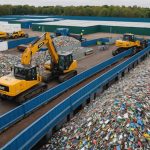Launching a UK Recycling Center: A Comprehensive Guide to Navigating Environmental Regulations
Understanding the Need for Recycling Centers
In the UK, the importance of recycling cannot be overstated. With the country aiming to achieve a net zero carbon footprint by 2050, recycling centers play a crucial role in reducing waste, conserving resources, and mitigating the environmental impact of human activities. If you are considering launching a recycling center in the UK, this guide will walk you through the essential steps and regulations you need to navigate.
Planning Your Recycling Business
Developing a Business Plan
Before diving into the operational aspects, it’s vital to create a solid business plan. Here are some key elements to include:
Also to read : Your ultimate roadmap to starting a successful uk virtual bookkeeping business
- Market Research: Identify your target market and understand the local demand for recycling services. Analyze the competition and assess the market size.
- Financial Projections: Estimate your startup costs, operational expenses, and potential revenue streams. Consider funding options and potential grants or subsidies.
- Services Offered: Determine the types of materials you will recycle, such as paper, plastic, glass, or hazardous waste. This will help you tailor your facilities and equipment.
- Location: Choose a location that is easily accessible and compliant with local zoning regulations. Ensure it is close to your target market to reduce transportation costs.
### Business Plan Template
- **Executive Summary**:
- Overview of your recycling business
- Mission and vision statements
- **Market Analysis**:
- Target market identification
- Market size and growth potential
- Competitive analysis
- **Services and Products**:
- Types of materials to be recycled
- Value-added products or services
- **Marketing and Sales Strategy**:
- How you will attract customers
- Pricing strategy
- **Operations Plan**:
- Facility layout and equipment needs
- Staffing and training requirements
- **Financial Plan**:
- Startup costs and funding sources
- Revenue projections and expense estimates
- **Management and Organization**:
- Key personnel and their roles
- Organizational structure
Navigating Environmental Regulations
Compliance with EU and UK Regulations
The UK, although no longer part of the EU, still adheres to many of the environmental regulations that were in place during its membership. Here are some key regulations you need to comply with:
- Waste Electrical and Electronic Equipment (WEEE) Directive: Ensure that your recycling center is registered and compliant with the WEEE regulations. This involves proper disposal and recycling of electronic waste[1].
- REACH Regulation: If your recycling process involves handling chemicals, you must comply with the Registration, Evaluation, Authorization, and Restriction of Chemicals (REACH) regulation. This includes identifying and reporting the use of Substances of Very High Concern (SVHC)[1].
- Battery Recycling: Ensure that you follow local regulations for the collection and recycling of batteries. This may involve registering with local authorities and adhering to specific guidelines[1].
Producer Responsibility
Under UK law, producers of certain products are responsible for the waste generated by those products. This includes packaging, electronics, and batteries. Your recycling center may need to work with producers to ensure that they meet their obligations.
Also read : Your ultimate roadmap to starting a successful uk virtual bookkeeping business
### Key Environmental Regulations
- **WEEE Directive**:
- Register your recycling center
- Ensure proper disposal and recycling of electronic waste
- **REACH Regulation**:
- Identify and report SVHC
- Comply with legal obligations for chemical handling
- **Battery Recycling**:
- Register with local authorities
- Follow specific guidelines for battery collection and recycling
- **Producer Responsibility**:
- Work with producers to ensure they meet their waste management obligations
Setting Up Your Recycling Center
Construction and Infrastructure
When setting up your recycling center, it’s crucial to consider the environmental impact of the construction process itself. Here are some tips:
- Sustainable Construction: Use sustainable materials and practices in the construction of your facility. This could include using recycled materials, energy-efficient systems, and green building certifications like LEED[1].
- Energy Efficiency: Invest in renewable energy sources such as solar panels to power your operations. This not only reduces your environmental footprint but also lowers operational costs.
- Water Conservation: Implement water-saving measures to minimize water usage in your operations.
### Sustainable Construction Tips
- **Use Recycled Materials**: Incorporate recycled materials in the construction of your facility.
- **Energy-Efficient Systems**: Install energy-efficient lighting, HVAC systems, and equipment.
- **Renewable Energy**: Use solar panels or other renewable energy sources to power your operations.
- **Water Conservation**: Implement water-saving measures such as low-flow fixtures and rainwater harvesting systems.
Equipment and Technology
Choosing the right equipment and technology is essential for efficient and effective recycling operations.
- Sorting Technology: Invest in advanced sorting technologies that can efficiently separate different types of materials.
- Crushing and Shredding: Use high-quality crushing and shredding equipment to process materials into recyclable forms.
- Data Management: Implement a robust data management system to track the flow of materials, monitor efficiency, and comply with regulatory reporting requirements.
### Essential Equipment for Recycling Centers
- **Sorting Machines**: Advanced sorting technologies for separating materials
- **Crushing and Shredding Equipment**: High-quality machinery for processing materials
- **Data Management Systems**: Robust systems for tracking material flow and monitoring efficiency
- **Conveyor Belts and Handling Systems**: Efficient systems for moving materials through the facility
Managing Waste and Promoting a Circular Economy
Waste Reduction and Recycling
Effective waste management is at the heart of any recycling business. Here are some strategies to reduce waste and promote recycling:
- Source Segregation: Encourage source segregation of waste to ensure that materials are collected in a way that facilitates easy recycling.
- Education and Awareness: Educate the public and local businesses about the importance of recycling and how to properly prepare materials for recycling.
- Partnerships with Local Authorities: Collaborate with local authorities to implement effective waste management policies and promote recycling initiatives.
### Strategies for Waste Reduction and Recycling
- **Source Segregation**:
- Encourage households and businesses to separate waste at the source
- Provide clear guidelines on what materials can be recycled
- **Education and Awareness**:
- Conduct public awareness campaigns
- Provide educational materials and workshops
- **Partnerships with Local Authorities**:
- Collaborate on waste management policies
- Support local recycling initiatives
Circular Economy Practices
A circular economy aims to keep resources in use for as long as possible, extract the maximum value from them, and recover and regenerate materials at the end of their service life. Here’s how you can integrate circular economy practices into your recycling business:
- Design for Recyclability: Work with manufacturers to design products that are easier to recycle.
- Product Take-Back Programs: Implement take-back programs for products that are at the end of their life cycle.
- Closed-Loop Recycling: Aim for closed-loop recycling where materials are continuously cycled back into production.
### Implementing Circular Economy Practices
- **Design for Recyclability**:
- Collaborate with manufacturers to design recyclable products
- Use materials that are easy to recycle
- **Product Take-Back Programs**:
- Offer take-back programs for end-of-life products
- Encourage customers to return used products
- **Closed-Loop Recycling**:
- Ensure materials are continuously cycled back into production
- Minimize waste by keeping materials in use
Case Studies and Best Practices
DS Smith and Zalando Partnership
A notable example of circular economy practices in action is the partnership between DS Smith and Zalando. DS Smith, a global leader in sustainable packaging solutions, has extended its partnership with Zalando to provide e-commerce packaging solutions that are designed for recyclability and efficiency. This partnership highlights the importance of collaboration between businesses to achieve sustainable goals[3].
Marc Chiron, Director of Sales, Marketing, and Innovation at DS Smith, noted: “We are delighted to secure this preferred supplier contract with Zalando. This new agreement will allow us to build on our existing research and development and continue to create exceptional packaging solutions for Zalando’s product portfolio across Europe.”
Brainlab’s Environmental Commitment
Brainlab, a company specializing in medical technology, demonstrates a strong commitment to environmental sustainability. They have implemented processes to restrict the use of hazardous substances, adhering to REACH regulations and ensuring their products are designed for recyclability and ease of disposal[1].
Launching a recycling center in the UK requires a thorough understanding of environmental regulations, a well-planned business strategy, and a commitment to sustainable practices. By following the guidelines outlined in this article, you can ensure that your recycling business not only complies with regulations but also contributes to a more circular and sustainable economy.
Remember, every step towards reducing waste and promoting recycling is a step towards a healthier environment and a more sustainable future.
### Final Checklist for Launching a UK Recycling Center
- **Develop a Comprehensive Business Plan**
- **Comply with Environmental Regulations**
- Register with relevant authorities
- Adhere to WEEE, REACH, and battery recycling regulations
- **Set Up Sustainable Infrastructure**
- Use sustainable materials and energy-efficient systems
- Implement water conservation measures
- **Invest in Appropriate Equipment and Technology**
- Advanced sorting machines and data management systems
- **Promote Waste Reduction and Recycling**
- Encourage source segregation and public education
- Collaborate with local authorities
- **Integrate Circular Economy Practices**
- Design for recyclability and implement take-back programs
- Aim for closed-loop recycling











